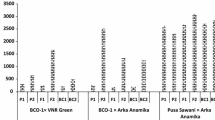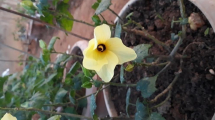Summary
Analysis of an incomplete diallel design with 14 hyacinth cultivars and 4 wild accessions of Hyacinthus orientalis showed a significant GCA component for resistance to yellow disease. The late flowering hyacinth cultivars ‘King of the Blues’ and ‘Marconi’ and the early flowering Hyacinthus orientalis 70129 were found to be the best combiners for yellow disease resistance. Within a cultivar, the degree of earliness itself was not associated with the degree of resistance. Correlation coefficients of leaf characters and degree of resistance showed that hyacinths with short and/or narrow leaves are generally more resistant than those with long and/or broad leaves. Tetraploid cultivars with few, large stomata tend to be susceptible, diploid ones with many small stomata tend to be the more resistant.
Similar content being viewed by others
References
Classified List and international register of hyacinths and other bulbous and tuberous-rooted plants, 1975. The Royal General Bulbgrower's Association, Hillegom, Holland, 277 pp.
Darlington, C. D., J. D., Hair & R., Hurcombe, 1951. The history of garden hyacinths. Heredity 5: 233–252.
Dye, D. W., 1958. Host specificity in Xanthomonas. Nature 182: 1813–1814.
Garretsen, Frida & M., Keuls, 1978. A general method for the analysis of genetic variation in complete and incomplete diallels and North Carolina II (NC 11) designs. Part II. Procedures and general formulas for the fixed model. Euphytica 27: 49–68.
Krelage, E. H., 1940. Het onderzoek der hyacinthenziekten. Een episode uit het prae-phytopathologische tijdvak. Tijdsch. Pl. Ziekt. 46: 30–45.
Krelage, E. H., 1946. Drie eeuwen bloembollenexport. 's Gravenhage, 791 pp.
Salltink, G. J., 1966. Hydathoden als mogelijke invalspoort voor Xanthomonas hyacinthi. Meded. Rijksfac. Landb. Gent 31: 941–949.
Schurer, K., 1971. Direct reading optical leaf area planimeter. Acta bot. neerl. 20: 132–140.
Tuyl, J. M., van & S. J., Toxopeus, 1980. Breeding for resistance to yellow disease of hyacinths. I. Investigations on F1's from diallel crosses. Euphytica 29: 555–560.
Author information
Authors and Affiliations
Rights and permissions
About this article
Cite this article
Van Tuyl, J.M. Breeding for resistance to yellow disease of hyacinths. II. Influence of flowering time, leaf characters, stomata and chromosome number on the degree of resistance. Euphytica 31, 621–628 (1982). https://doi.org/10.1007/BF00039200
Received:
Issue Date:
DOI: https://doi.org/10.1007/BF00039200




